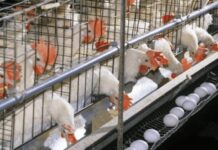
The practice of domesticating birds for production of meat, eggs, and feathers is called poultry farming. Chickens, Turkeys, Ducks, and Geese are the primary choice for the domestication, while Guinea Fowl and Squabs are domesticated based on the locality and interest. If you are planning to set up a poultry farm or have an idea to start one in the future, then you are at the right place. You will get to know the requisites, practices, and principles followed in poultry farming.
1. Choose your respective Poultry Sector first.
There are two types of poultry farming: Broilers and Layers. Broilers are chicken, raised for the sole purpose of production of meat. On the other hand, Layers are chicken raised for the production of eggs.
So, first, choosing from the sub-sectors of poultry farming helps you to plan and structure the finance aspects.
The five sub-sectors are:
- Meat Production.
- Egg Production.
- Poultry Feed Production.
- Chicken Breeding (Hatchery).
- Egg and Meat Processing.
Apart from the financial aspects, the architecture setup and location requirements depend upon the sub-sector you choose.
2. Next step is to choose the bird type.
If you are on a tight budget or on a mindset to experiment with a low budget, it is better to start poultry farming by choosing two to three bird types. As the next step with a stable financial base, you can include numerous bird types into production and scale up the business.
In general, poultry farmers choose to raise birds such as Domestic Fowl (chicken) as Broilers. On the other hand, they raise Duck, Goose, Quail, Peacock, Pigeon, Turkey as Layers.
3. The third step is to make your Farm Logo.
Brand value has an impact on the market. A well-designed logo is a primary requisite for your brand to get recognition and popularity out there in the market. Marketing your business is a must in the present scenario. A trendy logo adds up to the design and impression of your website.
Your logo represents the brand and will appear on your farm products, websites, visiting cards, advertisements and in every possible marketing domain. So, having an eye-catching logo is a must. It promotes your sales indirectly.
4. Be aware and alert about your Market.
Be aware of your buyers. Understand who your local buyers are. Are you selling to consumers directly from your farm or selling your products to wholesale or retailers do matter and will have an impact on your business.
Next prime aspect is, how will your consumers know where to find you and are they aware of the quality of the products you produce matter. Your consumers getting to know about and being happy about your products will impact your productivity and growth. Selling your products to wholesalers and restaurants will scale up your revenue and help you to have a reliable source of income.
5. Have a plan and blueprint.
Next to identifying the present market and the requisites, planning and setting up a blueprint according to your goal is what you have to do. Plan respectively to the market scale and first run. There are specific location requisites for the broilers and layers. So, Choose a location specific to the sub-sector you choose.
Feeding and providing a secure shelter to the poultry is a primary need. So, focus on the equipment such as fences, housing, waterers and feeders.
Next prime aspect is finance. Be clinical on your financial investment regarding the construction and feeding departments. Health care is the prominent aspect as you have to take care of the medications and vaccination on time. If you fail to handle this sector, then the productivity and revenue drop will be exponential. So, you need to be cautious.
6. Farm Location.
Choose the farm location to set up your poultry in the city outskirts will necessary requisites. Doing so will reduce effective land price, labor charges. But, do not choose a location which is too far from the concerned city or town. Choose your location having your target customers in mind. All these steps help you get the requisites on time and deliver the products sharply and scale up productivity.
7. Grow and Sell chickens regularly.
Buy a day old chickens, feed and nurture them till six weeks and then sell them. By doing so, you will be conserving feed, medicine and facilities required. And on the other hand, you will be generating income by selling them.
8. Marketing your Product.
Marketing is a prime aspect to do any business. For a quality product, a well-planned marketing strategy is necessary to boost its sales and to scale up the revenue. Selling your product in the nearby local markets help people get to know about your product. Efficient usage of digital marketing through websites and promoting your product on social media improves the sales and impressions on the brand. Traditional methods like promoting your product through adds and having visiting cards will help.
On the whole, before setting your farm, have these ideas in your mind. Firstly, visit some farms to have a practical idea of poultry farming. On visiting a farm, you will get to know the real-time best practices and steps to avoid while setting up the farm. Set up your farm on a small scale and you can expand your farm by time. As a tip, do sell your farm dung in summer. Renew the poultry birds every to scale up the productivity. The earnings will be high. If you practice best methods with a plan and execute it, high returns are guaranteed.

